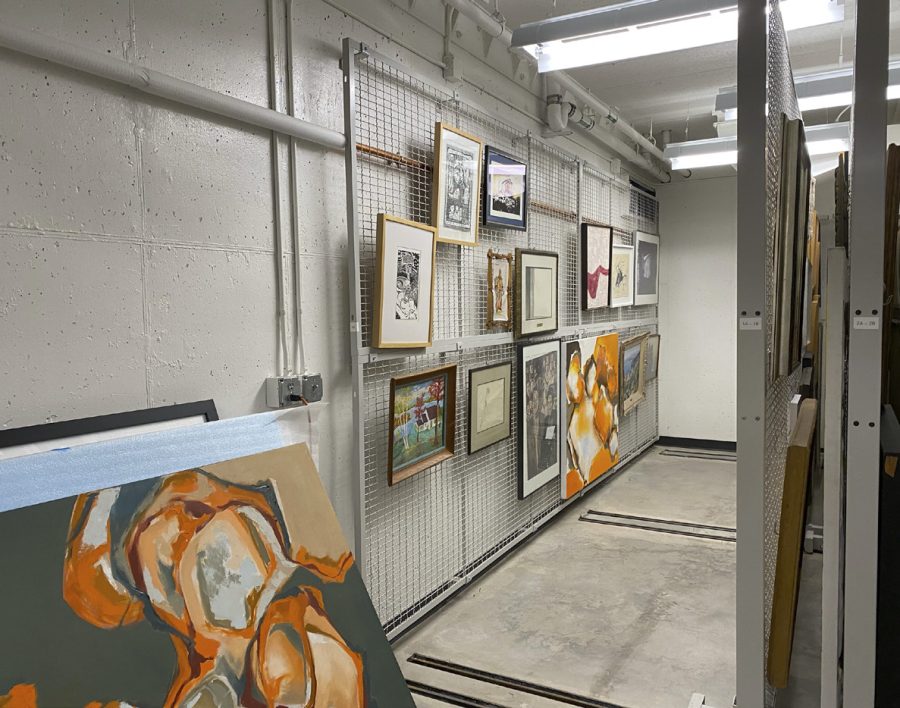Treasure trove of art in Macalester’s permanent collection
April 28, 2022
Macalester has long been a staple in the Twin Cities arts scene as a space where art, academia and institutional memory bring global perspectives in conversation with local ones. Professors have been included in world-renowned programs such as the Whitney Biennial, multi-disciplinary projects have been awarded grants in the millions and Grammy-award winning bands formed at Macalester perform at the Billboard Music Awards. What is less well known, however, is Macalester’s private art collection containing 1,600 pieces dating back to 960 A.D.
Housed in a climate-controlled room in the basement of the Janet Wallace Fine Arts Center (JWall), the collection ranges in art mediums, including photography, printmaking, sculpture, ceramics, textiles, painting and other artifacts of historical significance. A few of the more prolific artists in the collection include Judy Chicago, George Morrison, Cameron Booth, Jim Denomie, Pao Houa Her, Warren MacKenzie, Isamu Noguchi, Wing Young Huie and Joan Mitchell.
In contrast to art collections in a museum or from a private collector, Macalester does not have a specific time period or genre of art as the collection’s focus. With the exception of the Luksan Fund to purchase student work, Macalester also does not have an acquisitions budget to procure art; almost all of the pieces come to Macalester through donors, alumni, past faculty and students or other people connected with the college.
“Macalester’s collection, while we can use chronology to date the work and distribute it across time, it’s really a relational collection,” curator and director of the Law Warschaw Gallery Jehra Patrick said. “It’s based on who has had relationships with Macalester.”
The Art and Art History Department began accepting donations and making small acquisitions of art in 1960, with Patrick at the helm since 2016. Many academic departments at Macalester have their own archives or collections, but what makes the art collection unique is its breadth and close relationship to the institution. Despite not actively collecting to fill in a historical period, Patrick says that the history represented in the collection is actually quite robust due to the artists’ own reflections of the time periods they create in.
Work from the collection can be seen on view in buildings around campus and most of that work is chosen specifically for the location; fundraising campaigns to construct a new building often include efforts to purchase art to hang on the walls. This is needed in part because the art in Macalester’s permanent collection is too high of value to put in a public space — some works in the collection are worth millions. How a piece of art will hold up over time under UV rays or other kinds of weathering needs to be taken into account when putting something on display, and some artwork might have insurance attached to it.
“I know there’s a lot of interest in reinvigorating spaces with art,” Patrick said. “And ideally, I’d love to see those refreshed [maybe] semi-annually to keep the campus feeling activated. But it’s a colossal effort.”
The Law Warschaw Gallery, one of the most well known art spaces on campus and home of Patrick’s curatorial presence, is separate from the permanent collection. Adding the four annual visiting exhibitions to the permanent collection would both be too expensive and physically demanding. However, the exhibit prints and program materials from the gallery are added to the collection. These complications, along with the Law Warschaw Gallery’s exhibition programming, make it difficult to circulate art in Macalester’s relatively low-security buildings.
As for the rest of the collection’s visibility beyond the JWall basement, Patrick has loaned pieces to the Walker Art Center and other museums, but finds most often people reach out for digital images of artwork. Protecting the safety of each piece is integral to the collection’s mission statement of “acquiring artworks that [they] can sustainably circulate, store and conserve.”
In addition to the tangible objects, there’s a digital component of the collection. Since Patrick’s arrival at Macalester in 2016, she’s worked to bridge the gap between both parts of the collection for the public.
“I think about them as the same thing and two different things because they provide access in different ways,” Patrick said. “You can access [the collection] in person and sort of gain an understanding [of] an object by viewing it and by being in space with it while [also] thinking about what it means to live and study among works of art. And the other is, how do we create access to that content if we can’t see it in person? And that’s through digital data management.”
A huge part of Patrick’s work is digitizing the artwork and creating an interactive database containing the art’s location, value, history and connection to the college.
“When I arrived, we didn’t have a formal database for the art,” Patrick said. “So one thing [I] think about is, there’s the physical collection and what it can offer, and then there’s the data around that, which is the digital collection. And the way that we manage the physical collection is through the data management process.”
Many questions remain for Patrick as Macalester’s role as a collecting entity remains in flux, even as the relational approach for collecting satisfies the goals of equity, encapsulating the college’s values and the art pieces’ own safety.
“What is the intention of this collection?” Patrick said. “What I would be interested in continuing to promote is how we value the collection as a college. What does it mean to collect as a college? Are these intended to be learning objects? Are these things that we’re collecting for cultural value? And that word ‘cultural’ value can be subjective. Do we value the content of the work? Do we value artists themselves and want to value them by collecting their work? Or is it [that] the content is in line with Macalester’s values?”
The meaning, presentation and publication of the permanent collection will continue to evolve, and Patrick hopes for more engagement once the database is finished and public. To check out what is on view now, go to macalester.edu/gallery/.














